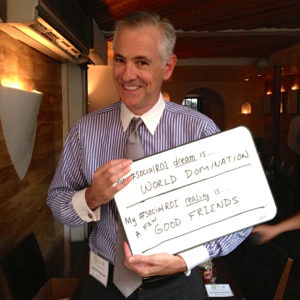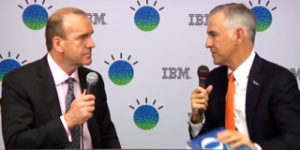
“So do you think all this influencer marketing stuff is overhyped?” asked the CMO standing next to me last night. Like a veteran batter expecting and getting a curveball, I didn’t swing at this one too hard but rather went with the pitch so to speak, letting the conversation ebb and flow until it landed in just the right spot. That spot, for me, is the influencer marketing program conceived and lead by IBMer Tami Cannizzaro.
And while I’ve covered some of my learnings about the IBM program on this blog already, I hadn’t gone to the source and discussed things like how the program came into being, success metrics and the importance of not just “talking the talk” as a client. This last point above all really struck home–if you want to run an influencer program especially a B2B one, then at least one individual at the brand needs to invest the time to build individual relationships with the influencers and actively participate in their conversations. Here is my conversation with Tami which also serves as an insightful preview into our panel discussion next week at the MediaPost Social Media Insider Summit.
Drew: When did the “VIP Influencer” program you are running for IBM Smarter Commerce conferences begin, where did the idea come from and what were your expectations Year 1?
I had to think about this one, Drew! I recall speaking at a CMO Club Summit event in New York about two years ago and Ted Rubin and Margaret Molloy were sitting in the audience. They both actively tweeted my session and it received lots of great pickup by influential people in the marketing community. It hit me that we could scale this phenomenon and invite prolific social influencers to our events to extend the reach of the content beyond the four walls of the conference. In year one, my objective was simply to drive a robust social conversation that would amplify all of the great content coming out of the conference.
Drew: Did the program evolve in Year 2 (2013) and if so how?
By year two, we scaled the program to 25 influencers and hired social media reporters to amplify the content. These social reporters tweeted, wrote short blogs and created shareable video content about the event. All reporters tweeted under a branded backchannel and identified themselves as reporters hired by IBM, so it was transparent. Between the influencer community and the reporters on site, the single conference this year yielded almost 300 million impressions and trended on Twitter as well. We also added a Social Business Command Center, which brought the activity to life and helped support broader participation and competition among our influencers. (I can still be heard bragging from time to time about my stint on the leader board!)
Drew: What are the factors that guided you in putting together a list of influencers for the IBM Smarter Commerce Summits?
My social media team monitors social channels and measures those influencers with the most “signal” in our industry—tools like OneQube can help you navigate, measure and manage social relationships. We wanted to field a group of influencers who were prolific at generating content and who also had a very engaged following. Some notable people include Jay Baer, Ted Rubin, Pam Moore, Bryan Kramer, Kim Garst, and Glen Gilmore. They have an active and influential voice in the community and a daily cadence of active publishing.
Drew: Are there any pitfalls to avoid when putting together a program like this?
The hard part is that you have to depend on good faith that the investment will yield. If you have a CEO focused on ROI, it may not be immediately evident how it’s returning back to the business. I liken it to a relationship with the analyst community. Nurtured over time, these relationships help you to build traction in the market and drive momentum for your brand. The pitfall is that it takes faith—and a lot of times, that isn’t enough to garner support for the program in the first place!
Drew: I couldn’t help but notice that your VIP Influencers bonded at the event. Was this part of your plan or just a happy by-product?
The misconception exists that social is just about digital—and that interacting on Twitter or Facebook is the whole power of social media. But the biggest payoffs can happen when the physical and digital worlds merge and people from social channels like Facebook or Twitter become in-person friends, colleagues, and customers. It sounds hokey, but there is tremendous power in building community, and that, to my mind, is at the core of an influencer program: Building a community of like-minded people who know and support one another.
Drew: You personally have invested a lot of time getting to know these influencers. Is that an essential part of these kinds of programs or could a marketer try to run an influencer program like yours without being personally involved?
Outsourcing the program completely to a staff person or an agency is missing the point of an influencer program, which is to make these people part of your overall brand strategy, to treat them like VIPs and give them insider access to your strategy and brand. Influencers tend to be a passionate, entrepreneurial community. Sharing your passion for your business with them and asking for their help to accomplish this is perhaps the secret ingredient of a successful influencer program.
Drew: Clearly there are costs (time, OOP) associated with assembling an influencer program list this. Can you speak to the costs and what kind of metrics/KPIs you use to rationalize this investment?
The time and investment is significant, but it’s one of the best parts of my job. Becoming a member of the influencer community has enriched my knowledge of the industry and paid me back in a number of ways. There are also measurable success factors. We actively measure the increase in engagement for our properties. For example, years ago, we were seeing limited pickup and reach from our social efforts. Today we have surpassed over 2 billion impressions and we’ve seen a significant increase in engagement on our owned properties. Driving from owned to earned is a slow process since you need to build a community and following over time, but it is definitely measurable.
Drew: Seems to me, you are still getting “ink” from some of the influencers (like me!) How do you extend the value of your investment in an influencer program?
We’ve asked some of our influencers to be guest bloggers on an ongoing basis. We also activity promote our influencers throughout the year so they receive value from IBM. IBM has a strong social fabric—one that’s getting stronger every day—and that’s helping to extend the value of being aligned with the IBM brand.
If you had one word of advice for a brand starting an influencer program, what would it be?
If you’re going to start an influencer program, take the time to think through the process of choosing the right brand sponsor within your organization. The program need to be nurtured by someone who will invest the necessary time and personal investment. It’s not a one-shot event—it’s a strategy that will evolve over time. Ted Rubin, Chief Social Marketing Officer of Collective Bias, has coined the phrase “Return on Relationship.” I agree with his thinking here. Social business is not about making a business transaction. It’s about building a network of business relationships that will yield results over time. You’ll get as much out of the program as you put into it.


